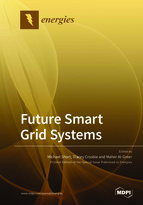Future Smart Grid Systems
A special issue of Energies (ISSN 1996-1073). This special issue belongs to the section "A1: Smart Grids and Microgrids".
Deadline for manuscript submissions: closed (24 February 2021) | Viewed by 41434
Special Issue Editors
Interests: control and protection; optimization; embedded systems; real-time systems; industry 4.0; industrial digitization and smart factories; smart grids; smart energy systems; advanced robotics/process control
Special Issues, Collections and Topics in MDPI journals
Interests: research methodologies; sustainability policy; sustainable urban development; smart cities and smart energy infrastructures
Special Issues, Collections and Topics in MDPI journals
Interests: system identification and intelligent control; power converter design and control; battery characterization
Special Issues, Collections and Topics in MDPI journals
Special Issue Information
Dear Colleagues,
Smart grids are electrical grids that include a variety of interoperable communication and control devices, which optimally facilitate the production and distribution of electricity. Smart grids allow better integration of renewable energy sources, flexible transmission resources, energy storage devices, electric vehicles, microgrids and controllable loads; they are seen as key enablers in the decarbonisation of both industry and society. This Special Issue focuses on the analysis, design and implementation of future smart grid systems. Submissions are invited from researchers and practitioners working in related areas, and to promote a venue for cutting-edge fundamental and applied research related to future smart grid.
Dr. Michael Short
Dr. Tracey Crosbie
Dr. Maher Al-Greer
Guest Editors
Manuscript Submission Information
Manuscripts should be submitted online at www.mdpi.com by registering and logging in to this website. Once you are registered, click here to go to the submission form. Manuscripts can be submitted until the deadline. All submissions that pass pre-check are peer-reviewed. Accepted papers will be published continuously in the journal (as soon as accepted) and will be listed together on the special issue website. Research articles, review articles as well as short communications are invited. For planned papers, a title and short abstract (about 100 words) can be sent to the Editorial Office for announcement on this website.
Submitted manuscripts should not have been published previously, nor be under consideration for publication elsewhere (except conference proceedings papers). All manuscripts are thoroughly refereed through a single-blind peer-review process. A guide for authors and other relevant information for submission of manuscripts is available on the Instructions for Authors page. Energies is an international peer-reviewed open access semimonthly journal published by MDPI.
Please visit the Instructions for Authors page before submitting a manuscript. The Article Processing Charge (APC) for publication in this open access journal is 2600 CHF (Swiss Francs). Submitted papers should be well formatted and use good English. Authors may use MDPI's English editing service prior to publication or during author revisions.
Keywords
- New and emerging paradigms for smart grid communication networks
- Digitisation of the electrical grid
- Smart grid cybersecurity
- Power converters for smart grid applications
- Automation, control and optimisation for smart grids
- Integration and interoperability of smart grid devices
- Modelling and simulation techniques for smart grids
- Renewable technologies
- Battery storage
- Energy management systems and advanced control
- Microgrids and sustainable communities
- Regulatory and technoeconomic aspects of smart grids








